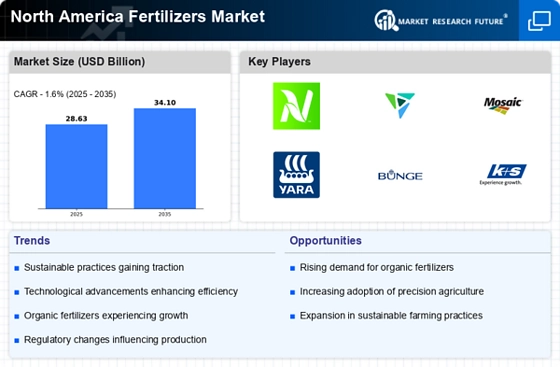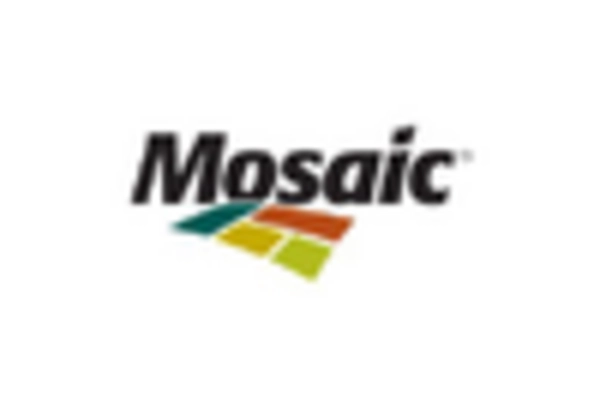Rising Agricultural Production
The North America Fertilizers Market is experiencing a surge in demand driven by the increasing agricultural production across the region. As farmers strive to meet the growing food requirements of a rising population, the need for fertilizers has become paramount. In 2025, the agricultural sector in North America is projected to grow at a rate of approximately 3.5% annually, necessitating enhanced fertilizer application to boost crop yields. This trend is particularly evident in staple crops such as corn and soybeans, where fertilizer usage is critical for achieving optimal growth. Consequently, the North America Fertilizers Market is likely to witness a robust expansion as agricultural stakeholders invest in fertilizers to enhance productivity and ensure food security.
Government Support and Subsidies
Government policies play a crucial role in shaping the North America Fertilizers Market. Various federal and state initiatives aimed at promoting sustainable agricultural practices have led to increased financial support for fertilizer use. Subsidies for nitrogen and phosphorus fertilizers, for instance, have been implemented to encourage farmers to adopt modern farming techniques. In 2025, it is estimated that government funding for agricultural inputs, including fertilizers, will reach approximately 1.2 billion USD, reflecting a commitment to enhancing agricultural efficiency. This financial backing not only stimulates demand for fertilizers but also fosters innovation within the North America Fertilizers Market, as manufacturers develop new products to meet evolving regulatory standards.
Increasing Awareness of Soil Health
The growing awareness of soil health and its impact on agricultural productivity is emerging as a key driver in the North America Fertilizers Market. Farmers are increasingly recognizing the importance of maintaining soil fertility to ensure sustainable crop production. In 2025, educational programs and workshops focusing on soil management practices are expected to proliferate, leading to a heightened demand for fertilizers that enhance soil quality. This trend is likely to result in a shift towards organic and eco-friendly fertilizers, as farmers seek to improve soil health while adhering to environmental regulations. Consequently, the North America Fertilizers Market may experience a diversification of product offerings to cater to this evolving consumer preference.
Rising Demand for Bio-based Fertilizers
The North America Fertilizers Market is witnessing a notable shift towards bio-based fertilizers, driven by increasing consumer demand for sustainable agricultural practices. As environmental concerns gain prominence, farmers are exploring alternatives to traditional chemical fertilizers. In 2025, the bio-based fertilizer segment is projected to grow at a compound annual growth rate of approximately 5%, reflecting a broader trend towards sustainability in agriculture. This shift is not only beneficial for the environment but also aligns with consumer preferences for organic produce. As a result, manufacturers within the North America Fertilizers Market are likely to invest in research and development to create innovative bio-based products that meet the needs of environmentally conscious farmers.
Technological Innovations in Fertilizer Production
Technological advancements are significantly influencing the North America Fertilizers Market. Innovations in fertilizer production processes, such as precision agriculture and smart fertilizers, are enhancing efficiency and effectiveness. In 2025, the market is expected to see a rise in the adoption of technologies that optimize nutrient delivery to crops, thereby reducing waste and environmental impact. For instance, the integration of data analytics and IoT in farming practices allows for tailored fertilizer applications based on specific crop needs. This shift towards technology-driven solutions is likely to propel the North America Fertilizers Market forward, as both manufacturers and farmers seek to maximize yield while minimizing resource use.


















Leave a Comment